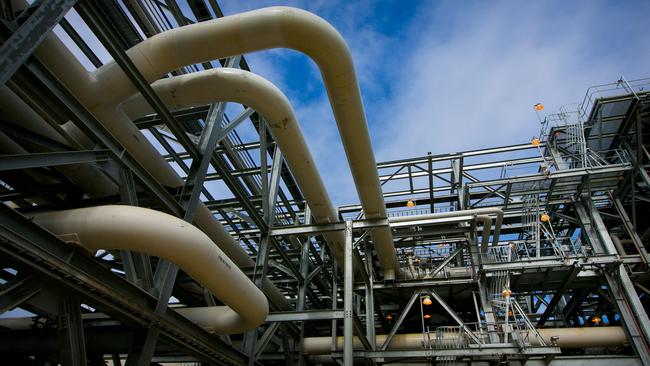Majors to head off gas squeeze
Gas exporters say they will push more production into east coast domestic markets.

Gas exporters say they will push more production into east coast domestic markets after a surprise drop-off in Bass Strait’s production outlook and increased gas power demand drove alarming supply shortage forecasts from the nation’s energy and competition watchdogs.
The unwelcome return to forecasts of a gas shortage next year came with revelations from the Australian Competition & Consumer Commission that records of board meetings at LNG exporters show expectations of a long-term domestic market shortfall that will not balance without more Queensland supply.
Pressure on east coast gas exporters led by Origin Energy, Shell and Santos was ratcheted up yesterday, as the Australian Energy Market Operator and ACCC both declared that a gas shortfall of 55-107 petajoules was on the way next year, increasing the prospect of government intervention that the industry says will put the nation’s reputation as a safe place to do business at risk.
Yesterday’s forecasts reversed a June AEMO report that eased previous 2018 shortage predictions because Gladstone’s LNG plants had reduced export forecasts.
Those export plans were cut further in AEMO’s update yesterday, but a fall in domestic gas production estimates and a jump in power demand expectations more than offset this.
Exxon confirmed it was expecting a dramatic 26 per cent drop in Bass Strait gas production from record levels this year that will extend to 2020.
This will put production at the nation’s biggest domestic gas producer, which last year supplied 19 per cent of east coast demand, back down to levels it was at from 2011 to 2015.
But it could see Exxon and joint venture partner BHP’s combined annual gas revenue drop by $700 million at current prices and it is the first indication the 40-year-old operation will not continue to support surging east coast gas demand, driven by Gladstone’s LNG plants.
The ACCC said the Gippsland Basin joint venture with BHP in Bass Strait had told it that production would rise from record 2016 production of 312 petajoules to 330 petajoules this year. But next year, production is expected to fall by 86 petajoules, more than AEMO’s expected east coast shortfall, to 244 petajoules.
An Exxon spokesman said the lower levels would continue until at least 2020.
“We continue to assess opportunities to bring additional supply to the domestic market with our efforts focused on both near-term and longer-term supply,” he said, stressing that the joint venture had invested $5.5 billion in the past decade to access more gas for domestic markets.
“While Esso and BHP supply a significant proportion of the eastern Australia marketplace, we only hold 5 per cent of eastern Australia’s high confidence gas reserves.”
With the nation’s gas chiefs to be called again to front Malcolm Turnbull this week to discuss whether the government will activate domestic gas restrictions, exporters were taking the need for more supply seriously.
The Australia Pacific LNG plant, 27.5 per cent-owned by Origin, said it was actively marketing more gas for domestic markets.
“We plan to review the AEMO data and consider what APLNG can do to help make sure the domestic market has the gas it needs in 2018,” APLNG chief Warwick King said.
Origin said it would also look at other measures outside the APLNG project.
“We are committed to meeting customer demand for gas and we are actively working to bring on more supply for 2017-18,” said Origin’s energy supply and operations head, Greg Jarvis.
Shell, which runs the Queensland Curtis LNG plant, said it would sell between 75 petajoules and 90 petajoules of gas into the domestic market this year, up from 50 petajoules in 2013.
The Australian Petroleum and Production Association called the shortfall forecasts “alarming” and said they were mainly due to increased gas-fired power demand.
“This analysis reinforces how vital it is for all governments to support developing new gas supplies as quickly and as cheaply as possible,” APPEA chief executive Malcolm Roberts said.
“The gas industry is striving to lift production, often in the face of regulatory barriers and escalating costs.”
Santos, which will bear the brunt of export controls under the Domestic Gas Market Security Mechanism in its current form, declined to comment.
The ACCC’s special powers to demand confidential documents have uncovered board documents at gas companies that suggest they are well aware of the domestic supply outlook.



To join the conversation, please log in. Don't have an account? Register
Join the conversation, you are commenting as Logout